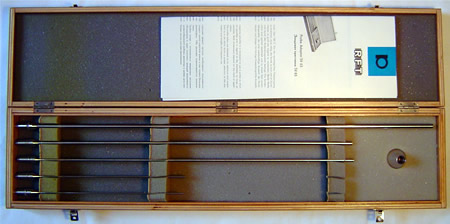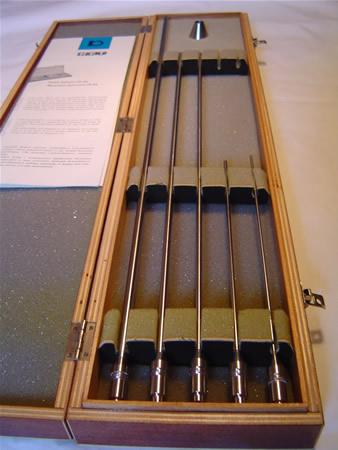Sondenvorsatz SV 63 für 1“ – Messmikrofonkapsel MK 102
Probe adapter SV 63 for 1“- measurement microphone capsule MK 102
Hersteller / manufacturer: RFT Mikrofontechnik Gefell
Baujahr: 1990
Wird als Vorsatzelektrode auf die 1“- Kapsel MK 102 aufgeschraubt. Sie dient zur Messung am Ohr, zur Messung der Schallisolation verschiedener Materialien, zur Messung des Schalldruckes an wenig zugänglichen, komplizierten Maschinenteilen, auch bei Temperaturen > +100 °C.
Für optimalen Frequenzgang sollten der Sondendurchmesser so groß wie möglich und die Länge so kurz wie möglich gewählt werden.

Abb. SV 63

Abb. SV 63
Anwendung
Der 1“ -Sondenvorsatz SV 63 dient in Verbindung mit der 1“ –Kondensator-Messmikrofonkapsel MK 102 und dem Messmikrofonvorverstärkern MV 101 oder MV 102 bzw. über den Adapter A 63 mit dem ½“-Messmikrofonvorverstärker MV 201 etc. einer Vielzahl von Messungen, wie zum Beispiel Messungen im Ohr, Messungen der Schallisolation diverser Materialien und Messungen an komplizierten Maschinen in engen oder an unzugänglichen Stellen. Der Sondenvorsatz kommt auch bei Temperaturen über +100 °C zur Anwendung. Um den bestmöglichen Frequenzgang zu erreichen, ist es nötig, die Sonde so kurz und im Durchmesser so groß wie möglich zu verwenden. Beide Maße sind durch die Art und Weise des Einsatzes bedingt. Die Sondenrohre sind optimal bedämpft und zu einem Satz zusammengestellt, der eine zweckmäßige Auswahl der Durchmesser und Längen für häufige Anwendungsfälle darstellt.
Aufbau und Wirkungsweise
Der Sondenvorsatz SV 63 besteht aus einem Konus, einer Dichtungsscheibe und fünf individuell abgestimmten Sondenrohren. Jedes Sondenrohr ist mit einem Gewindestück versehen, um es erforderlichenfalls im Betriebszustand des Messmikrofons gegen ein anderes austauschen zu können.
Das im Vorderteil des Rohres befindliche Kupferknäuel dient der Dämpfung der Sonde. Die Dichtungsscheibe verhindert einen Druckausgleich mit dem hinter der Mikrofonmembran befindlichen Hohlraum.
Inbetriebnahme
Das Ausgewählte Sondenrohr ist mit dem Konus zu verschrauben. Die Sonde wird anstelle der Vorsatzelektrode (Kappe der Mikrofonkapsel) vorsichtig auf die Messmikrofonkapsel geschraubt bis ein deutlicher Widerstand spürbar ist.
Vor dem Aufschrauben der Sonde ist auf die richtige Lage der Dichtungsscheibe im Konus zu achten und der Staub von der Membran der Messmikrofonkapsel bei abgeschalteter Betriebsspannung mit einem weichen Tuch äußerst sorgfältig zu entfernen.
Technische Daten
Sondenaußendurchmesser: 2; 3; 4; 5; 6 mm
Sondenlänge : 200; 200; 400; 400; 500 mm
Masse: ca. 110 g
Lieferung im Holzetui: (B x H x T) (530 x 50 x 120) mm
Probe Adapter SV 63 for 1”- measurement microphone capsules
Manufacturer: RFT VEB Mikrofontechnik Gefell
Application
The probe adapter SV 63 in connection with the condenser measurement microphone capsule MK 102 and the microphone preamplifier MV 101 or MK 102 or by means of the adapter A 63 with the microphone preamplifier MV 201 etc. is used for a great number of measurements such as measurements in the ear, measuring the sound insulation of various materials and measurements on complicate machines, in narrow or inaccessible places, even at temperatures above 100 °C.
To achieve the best frequency response possible it is necessary to use a probe as short as possible and in regard to the diameter as large as possible. Both dimensions depend on the field of application.
The probe tubes are damped at an optimum and assembled to a set which forms a proper selection of the diameters and length for frequent use.
Construction and Mode of Action
The probe adapter SV 63 consists of a cone, a packing disk and fife tubes individually tuned. Each probe tube is provided with a threaded portion in order to exchange it with any other one during service condition of the standard microphone, if required.
The copper ball provided in the front part of the tube serves as a damping means of the probe. The packing disk prevents a compensation of the pressure with the cavity provided behind the microphone membrane.
Putting into Operation
The probe tube selected must be screwed to the cone. The adapter electrode is replaced by screwing the probe carefully onto the standard microphone capsule provided until a distinct resistance is noticeable.
Before the probe is screwed onto it the proper position of the packing disk in the cone be observed that the dust must be removed carefully from the membrane of the standard microphone capsule by means of a soft duster at operational voltage shut off.
Technical Data
Outside diameter of probe 2; 3; 4; 5; 6 mm
Length of probe 200; 200; 400; 400; 500 mm
Weight approx. 110 g
Delivery in a wooden case, the dimensions are (530 x 50 x 120) mm